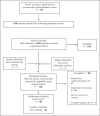Clinical Utility of Psychoeducational Interventions for Youth with Type 1 Diabetes: A Scoping Review
- PMID: 38774890
- PMCID: PMC11104390
- DOI: 10.5334/cie.28
Clinical Utility of Psychoeducational Interventions for Youth with Type 1 Diabetes: A Scoping Review
Abstract
Adolescence is a challenging time for the medical management of type 1 diabetes. Thus, a range of psychoeducational interventions have been developed to improve diabetes management among youth. Systematic reviews of this literature have emphasized the effectiveness of interventions for improving patient outcomes. However, knowledge beyond what works is required for interventions to be adopted into routine clinical practice. The objective of this scoping review was to map the clinical utility of the literature based on a variety of indicators, including the problem base, context placement, information gain, transparency, pragmatism, and patient-centeredness of the research. This lens for reviewing research is consistent with the biopsychosocial model and an increasing focus on reducing disability, including activity limitation and participation restriction. PsycINFO, MEDLINE, and CINHAL databases were searched for evaluative psychoeducational intervention studies published between January 2005 and October 2020. Two cited reference searches and one reference list search were also performed. Fifty studies describing 46 different interventions were identified. The clinical utility of the interventions was highly variable. A detailed overview of the clinical utility of the literature is provided with an emphasis on current gaps and shortcomings to be addressed in future research. This work helps advance the translation of clinical knowledge into practice in schools, homes, and communities; and, ultimately, improve the health and well-being of adolescents with T1D.
Keywords: adolescents; clinical utility; diabetes; psychoeducational interventions.
Copyright: © 2021 The Author(s).
Conflict of interest statement
The authors have no competing interests to declare.
Figures
Similar articles
-
Beyond the black stump: rapid reviews of health research issues affecting regional, rural and remote Australia.Med J Aust. 2020 Dec;213 Suppl 11:S3-S32.e1. doi: 10.5694/mja2.50881. Med J Aust. 2020. PMID: 33314144
-
The future of Cochrane Neonatal.Early Hum Dev. 2020 Nov;150:105191. doi: 10.1016/j.earlhumdev.2020.105191. Epub 2020 Sep 12. Early Hum Dev. 2020. PMID: 33036834
-
Psychoeducational group interventions for adults diagnosed with attention-deficit/ hyperactivity disorder: a scoping review of feasibility, acceptability, and outcome measures.BMC Psychiatry. 2024 Jun 20;24(1):463. doi: 10.1186/s12888-024-05908-8. BMC Psychiatry. 2024. PMID: 38902683 Free PMC article.
-
Promoting and supporting self-management for adults living in the community with physical chronic illness: A systematic review of the effectiveness and meaningfulness of the patient-practitioner encounter.JBI Libr Syst Rev. 2009;7(13):492-582. doi: 10.11124/01938924-200907130-00001. JBI Libr Syst Rev. 2009. PMID: 27819974
-
Strategies used for childhood chronic functional constipation: the SUCCESS evidence synthesis.Health Technol Assess. 2024 Jan;28(5):1-266. doi: 10.3310/PLTR9622. Health Technol Assess. 2024. PMID: 38343084 Free PMC article.
References
-
- Abraham, M. B., Jones, T. W., Naranjo, D., Karges, B., Oduwole, A., Tauschmann, M., & Maahs, D. M. (2018). ISPAD clinical practice consensus guidelines 2018: Assessment and management of hypoglycemia in children and adolescents with diabetes. Pediatric Diabetes, 19, 178–192. DOI: 10.1111/pedi.12698 - DOI - PubMed
-
- Aguilar, M. J., Pedro, A. G., Gonzalez, E., Perez, M. C., & Padilla, C. A. (2011). A nursing educational intervention helped by One Touch UltraSmartTM improves monitoring and glycated haemoglobin levels in type I diabetic children. Journal of Clinical Nursing, 21, 1024–1032. DOI: 10.1111/j.1365-2702.2011.03926.x - DOI - PubMed
-
- Akhter, K., Turnbull, T., & Simmons, D. (2018). A systematic review of parent/peer-based group interventions for adolescents with type 1 diabetes: Interventions based on theoretical/therapeutic frameworks. British Journal of Diabetes, 18(2), 51–65. DOI: 10.15277/bjd.2018.177 - DOI
-
- American Diabetes Association. (2017). Factors affecting blood glucose. Retrieved from http://www.diabetes.org/living-with-diabetes/treatment-and-care/blood-gl...
-
- Arksey, H., & O’Malley, L. (2005). Scoping studies: Towards a methodological framework. International Journal of Social Research Methodology, 8(1), 19–32. DOI: 10.1080/1364557032000119616 - DOI
Publication types
LinkOut - more resources
Full Text Sources


